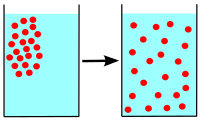
Photo from wikipedia
Estimating the longitudinal dispersion coefficient DL in flow through heterogeneous porous media is paramount to many problems in geological formations. Moreover, although it is well‐known that DL is sensitive to… Click to show full abstract
Estimating the longitudinal dispersion coefficient DL in flow through heterogeneous porous media is paramount to many problems in geological formations. Moreover, although it is well‐known that DL is sensitive to the morphology of such formations, it has been very difficult to establish a firm link between the two. We describe a novel deep convolutional neural network (DCNN) for estimating DL . The inputs for training of the network are a large and diverse set of data consisting of three‐dimensional images of porous media, as well as their porosity, and the associated DL values computed by random‐walk particle‐tracking (RWPT) simulations. The trained network predicts DL very rapidly, and its predictions are in excellent agreement with the data not used in the training. Thus, a combination of the DCNN and RWPT simulation provides a powerful tool for studying many flow‐related phenomena in geological formations, and estimating their properties.
Journal Title: Geophysical Research Letters
Year Published: 2021
Link to full text (if available)
Share on Social Media: Sign Up to like & get
recommendations!